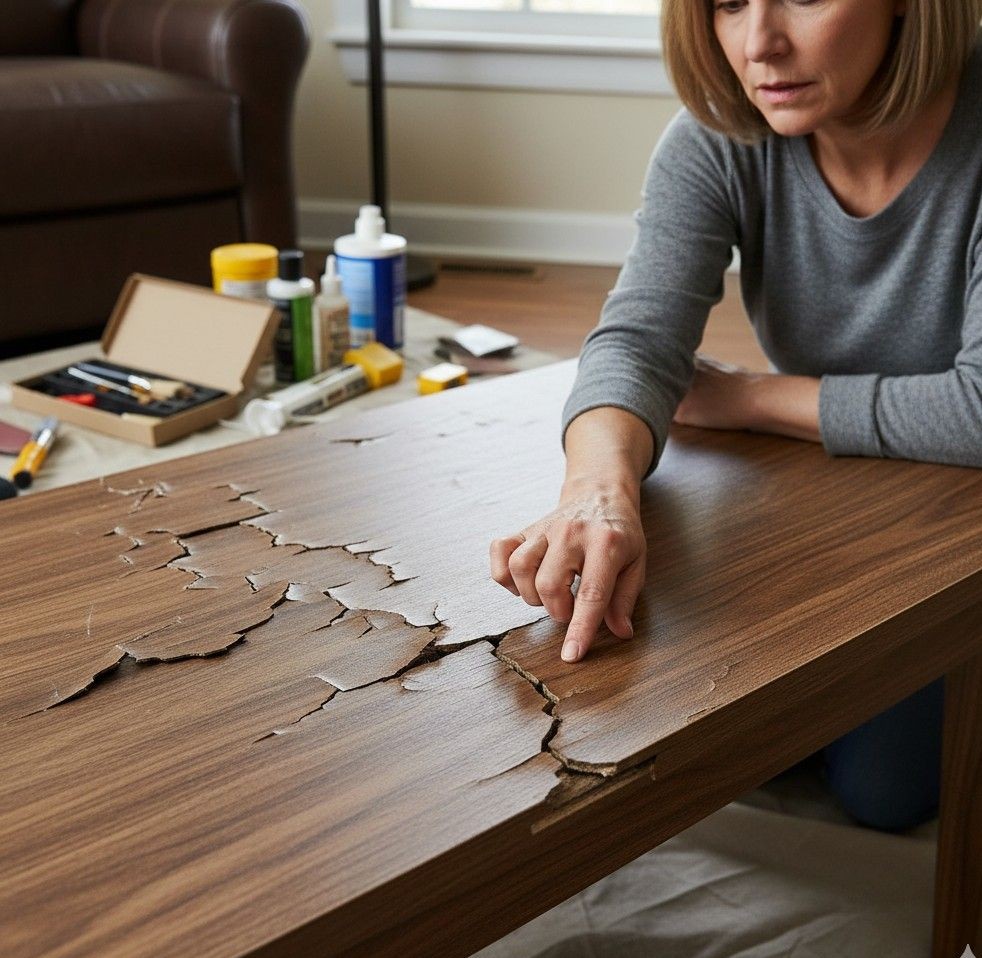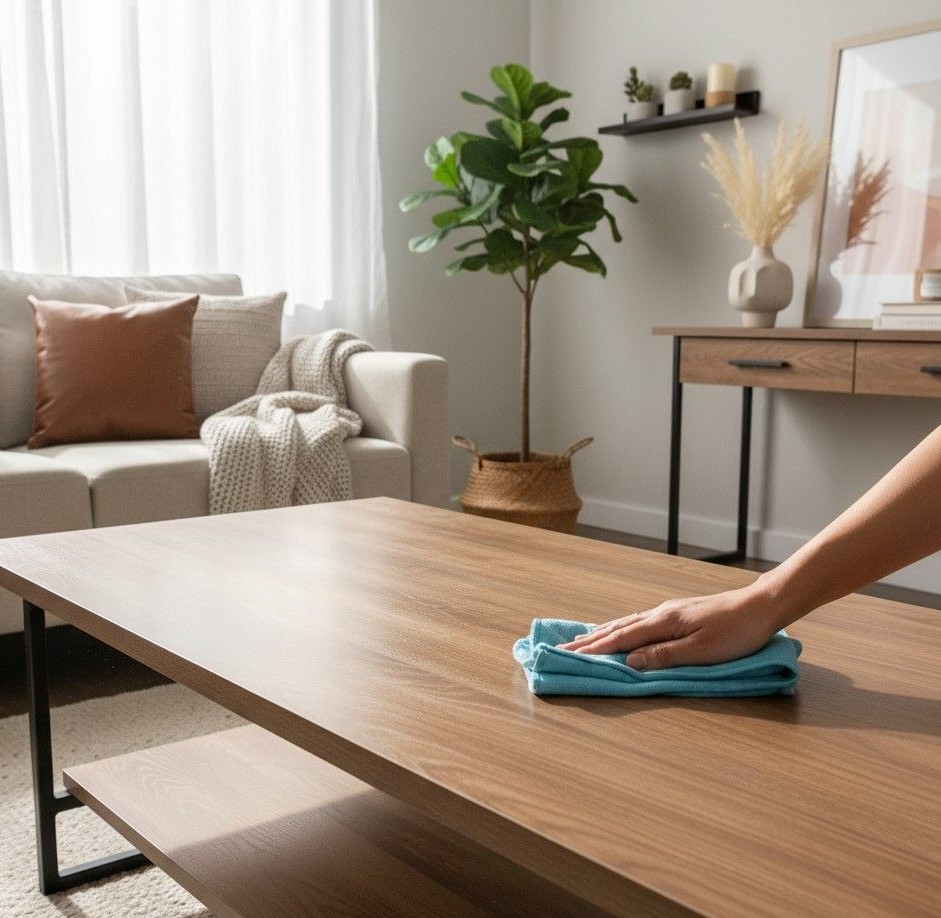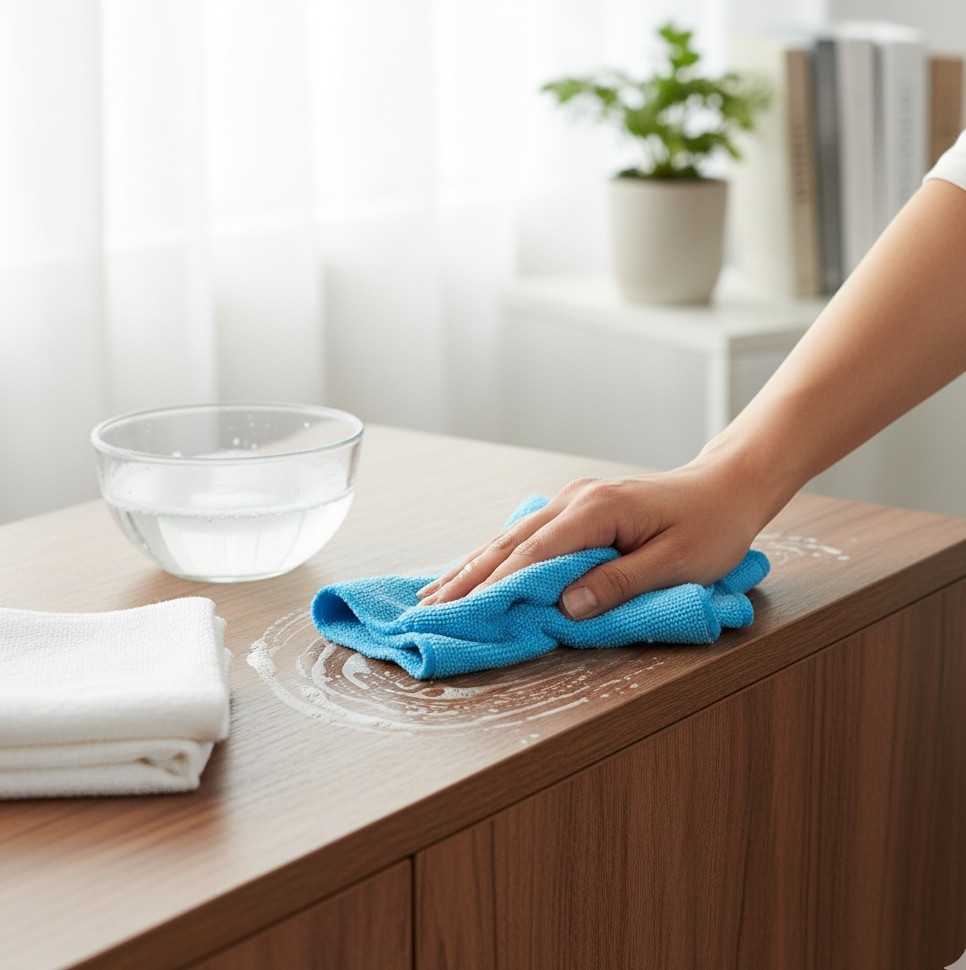Faux wood may look tough, but without the right care, it quickly loses its charm. Many homeowners unknowingly damage their furniture and shutters by using harsh cleaners or ignoring routine maintenance. The result? Warping, fading, and costly replacements that could have been avoided.
As experts in faux wood care, we’ve simplified the process into proven, safe methods you can trust. With a few easy adjustments, you’ll protect your investment, extend the life of your faux wood, and keep it looking as stunning as the day you bought it.
Understanding Faux Wood: What It Is and Why It’s Popular
Faux wood is a popular material. It looks like real wood. Many people choose faux wood because it is less expensive. It is also very flexible. You can find it in many colors and styles.
Faux wood products are common. They appear in homes everywhere. People use it for indoor furniture. Outdoor furniture also uses faux wood. It works well for doors. Windows and shutters often use it as well. Oridow makes faux wood shutters. These shutters are strong. They last a long time. They cost less than other options.
Faux wood is always getting better. Research helps make it stronger. It also helps make it resistant to the weather. Soon, faux wood may replace real wood. This material offers many benefits. It is durable. It resists elements well. This means it can handle the sun and rain. Your faux wood items stay nice.
Keeping faux wood clean is important. Proper care makes it last. Simple cleaning tips help. These tips are easy to follow. They protect your faux wood products.
The Basics: Everyday Maintenance for Lasting Faux Wood
Regular cleaning is key for faux wood. It keeps items looking new. Dust builds up quickly. You must remove it often.
Hosing
Water helps clean faux wood. A garden hose can do the job. The water reaches hidden spots. It cleans items from the inside. Do not use too much water. Keep the water pressure low.
High pressure can hurt faux wood. It weakens the material. Use gentle streams of water. This protects your items.
Regular Cleaning
Dusting is a must. Dust settles on faux wood items. Clean them often. A soft cloth works well. Dust daily or weekly. This stops dust from piling up.
Deep cleaning is also important. Do this every few months. Use mild soap. Mix it with lukewarm water. Dip a washcloth in the mix. Wipe down the faux wood surfaces. This removes dirt and grime.
After washing, wipe with a clean, wet cloth. This takes off soap. Your faux wood items will stay in top shape. They will look great all year.
Use of Mild Chemicals
Many cleaners have bad chemicals. These chemicals hurt people. They also damage surfaces. Harsh chemicals stain faux wood. They can destroy it. Always pick safe options. Choose organic cleaners.
Mild soap is a good choice. Avoid strong sprays. Do not use harsh detergents. Read labels carefully. Make sure the product is gentle. This keeps your faux wood safe. It helps it last longer.
Covering
Covering faux wood furniture can help. It protects from the weather. Experts agree this makes items last. But you choose what is best. Consider how you use the furniture. If covering is easy, do it. It helps shield from the sun and rain. This protection makes faux wood endure.
These tips are simple. They are also effective. You can easily apply them. Caring for your chic faux wood products is easy. Visit our products page. Find our great selection.
Deep Cleaning Your Faux Wood: Beyond the Hose and Dust Cloth
Regular cleaning keeps faux wood nice. Sometimes, you need more. Deep cleaning removes tough dirt. This helps faux wood stay strong. It also keeps it looking good.
Tackling Stubborn Stains on Faux Wood
Stains can happen. Food spills or dirt can stick. Act fast to clean stains. Fresh stains are easier to remove.
First, try mild soap and water. Mix a small amount of mild soap with lukewarm water. Use a soft cloth. Gently rub the stain. Work from the outside in.
This stops the stain from spreading. Rinse the cloth often. Change the water if it gets dirty.
For tougher stains, use a soft brush. A toothbrush can work. Scrub gently. Do not press too hard. Hard scrubbing can scratch faux wood. Rinse the area well. Wipe it dry. Make sure no soap is left. Soap can leave a film.
Some stains need special care. Ink marks or grease can be tricky to remove. For ink, use rubbing alcohol. Put a small amount on a cotton ball. Dab the stain. Do not rub. Rubbing can spread the ink.
For grease, try a degreaser. Choose an organic, gentle one. Always test new cleaners first. Test in a hidden spot. This ensures it will not harm your faux wood.
Always clean the whole area. Do not just clean the stain. This helps blend the cleaning. It prevents watermarks. Your faux wood will look even.
The Right Cleaning Solutions: DIY vs. Commercial Options
Choosing cleaners is important. Many options exist. You can make your own. You can buy commercial ones.
| Aspect | DIY Solutions | Commercial Solutions |
|---|---|---|
| Ingredients | Simple items like mild soap, vinegar, baking soda, water | Specially formulated cleaners labeled “faux wood safe” |
| Safety | Usually non-toxic, gentle, and eco-friendly | Can vary — always check labels for harsh chemicals |
| Cost | Low-cost, household staples | Often more expensive, recurring purchase |
| Effectiveness | Great for general cleaning, light stains, and odor removal | Designed for tougher stains and specialized care |
| Risks | Must measure carefully; vinegar may dull shine if overused | Harsh chemicals may damage, dull, or crack faux wood |
| Best Use | Everyday cleaning, preventive maintenance | Deep cleaning, stubborn stains, or professional-level finish |
Read More,
3 Ways To Protect Your House From Hurricanes
Are Aluminum Windows Worth the Investment?
10 Important Things to Consider When Building Your Home
Keep Aluminum Windows Shining: A Maintenance Guide
Protecting Your Faux Wood: Beyond Just Covering
Faux wood needs protection. Covering helps, but additional steps are required. Proper care keeps your items safe. It extends their life.
Sunlight, Moisture, and Temperature: Environmental Factors to Consider
The environment affects faux wood. Sun, water, and heat cause damage. Be aware of these factors.
Sunlight has strong UV rays. These rays fade colors. They make faux wood brittle. Keep faux wood products out of direct sunlight. Use blinds or curtains indoors.
For outdoor items, use shade. An umbrella or awning works well. Move furniture if possible. This lessens sun exposure. This helps colors stay bright. It keeps the material strong.
Moisture is another threat. Too much water can warp faux wood. It can cause swelling. Avoid leaving water on surfaces. Wipe up spills fast. Suppose you use a hose to dry items thoroughly.
Do not let water sit. Humidity also plays a role. High humidity can cause issues. Use a dehumidifier indoors if needed. Ensure good airflow around items. This prevents moisture buildup.
Temperature changes can harm faux wood. Extreme heat or cold is bad. Rapid shifts are worse. Heat can make material expand. Cold can make it shrink.
This constant movement causes cracks. It weakens the structure. Keep indoor items at a stable temperature. Do not place them near heaters. Do not place them near AC vents.
For outdoor faux wood, consider storage. Store it in a shed during harsh seasons. This protects it from extreme weather.
Common Faux Wood Cleaning Mistakes to Avoid
Some cleaning habits hurt faux wood. Knowing these mistakes helps. You can avoid damage.
First, avoid using harsh cleaners. We talked about this before. Strong chemicals destroy faux wood. They stain and break it down. Always pick mild soap or organic options.
Never use abrasive scrubbers. Steel wool or rough sponges scratch surfaces. Use soft cloths instead. Microfiber cloths are good.
Next, avoid too much water. Hosing is fine, but not excessive water. Water can seep into seams. It causes swelling and warping. Always use low pressure with a hose. Wipe surfaces dry after cleaning. Do not let water puddle.
Do not skip regular cleaning. Dust buildup hurts surfaces. It can make them dull. Dirt also acts like sandpaper. It scratches when wiped. Clean often. This prevents deep cleaning needs. It keeps your faux wood looking fresh and new.
Also, do not ignore small damage. A small scratch can grow. A tiny crack can spread. Fix minor issues fast. Use a repair kit if needed. Address problems early. This prevents bigger repairs later.
Lastly, do not forget protection. Covering items helps. Keeping them out of the harsh sun helps. Protecting from rain helps. Simple steps prevent big problems. These tips save you time. They also save money. Your faux wood will look good for a long time. It will stay strong and beautiful.
When to Call a Professional: Recognizing Severe Faux Wood Damage

Most faux wood care is easy. Sometimes, the damage is too much. You may need a professional. Know when to ask for help.
Severe damage needs expert eyes. Deep cracks are a bad sign. If the material warps significantly, seek assistance. Large, stubborn stains may require professional help.
If the finish peels off, contact a professional for assistance. These problems are hard to fix alone. Trying to fix them yourself may make the problem worse.
Professionals have special tools. They know specific techniques. They can repair damage safely. They can restore your faux wood. This saves your items. It helps them last even longer. Ask Oridow for advice. They can suggest good services. They want your faux wood products to last.
Key Takeaways:
-
Faux wood mimics real wood, offering affordability, durability, and wide use in furniture, doors, windows, and shutters.
-
Regular cleaning with soft cloths and mild soap preserves faux wood’s appearance and structural integrity.
-
Avoid harsh chemicals, abrasive scrubbers, and excess water to prevent staining, warping, and surface damage.
-
Protection from sunlight, moisture, and temperature extremes extends faux wood’s lifespan and prevents fading or cracking.
FAQs about Cleaning Faux Wood
1. What is the best way to clean faux wood furniture daily?
The simplest and most effective method is to dust regularly. A soft cloth or microfiber duster keeps surfaces free of buildup that can scratch over time.
-
Use a microfiber cloth or soft duster
-
Dust daily or at least weekly
-
Avoid rough or abrasive materials
2. Can I use a power washer on my outdoor faux wood items?
No. Power washers use high pressure that can damage the surface and weaken faux wood. Stick to a garden hose on low pressure for safe cleaning.
-
Use a garden hose with gentle water flow
-
Keep pressure low to avoid warping or cracking
-
Always dry items after rinsing
3. What kind of soap is safe for faux wood?
Mild soap is always best. Harsh detergents can strip finishes and shorten the lifespan of your furniture.
-
Mild dish soap diluted in water works well
-
Choose organic or plant-based cleaners
-
Avoid bleach, ammonia, or strong sprays
4. How do I remove stubborn stains from faux wood?
Start with mild soap and water, then step up to gentle specialty cleaners if needed. Always test in a hidden spot first.
-
Mild soap + lukewarm water for fresh stains
-
Use a soft brush (like a toothbrush) if necessary
-
Try rubbing alcohol for ink, gentle degreaser for grease
5. Does sunlight damage faux wood?
Yes. Prolonged exposure to UV rays can fade colors and make the material brittle.
-
Keep indoor items out of direct sun
-
Use curtains, blinds, or UV films on windows
-
Provide shade outdoors with umbrellas or awnings
6. Is it okay to leave faux wood furniture out in the rain?
While it resists moisture better than real wood, long-term exposure weakens faux wood. Always dry it after rain.
-
Wipe water off surfaces quickly
-
Don’t let puddles sit on faux wood
-
Store in covered areas during wet seasons
7. Should I cover my outdoor faux wood furniture?
Yes, covering adds an extra layer of protection from sun, rain, and dirt. It helps furniture last longer.
-
Use breathable, weatherproof covers
-
Cover furniture when not in use
-
Store indoors during extreme seasons
8. What if my faux wood develops deep cracks?
Deep cracks or warping signal it’s time for professional repair. DIY fixes may make damage worse.
-
Call a furniture repair expert
-
Seek advice from your product manufacturer
-
Don’t ignore small cracks—they spread over time
9. Are there cleaning solutions to avoid on faux wood?
Yes. Some products are too harsh and will damage finishes.
-
Avoid bleach, ammonia, and solvents
-
Stay away from abrasive powders or scrubbers
-
Only use cleaners labeled “safe for faux wood”
10. How often should I deep clean my faux wood products?
Plan a deep clean every few months, or sooner if items are heavily used.
-
Wash with mild soap and lukewarm water
-
Rinse thoroughly to remove residue
-
Dry completely with a clean cloth






